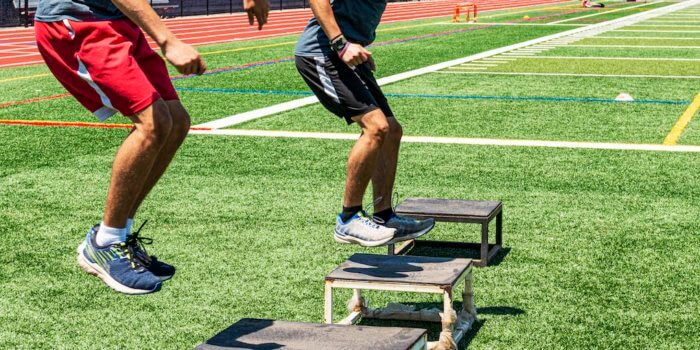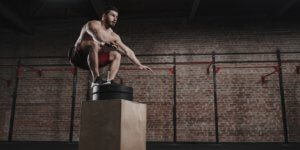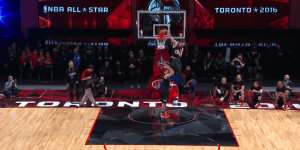The vertical jump is an integral part of a lot of sports. Volleyball, Track and Field, Football and of course Basketball all favor athletes that are able to jump high.
And the good news: everybody can improve their vertical jump with the right training!
I myself had great results with the Vert Shock program, an intense 8-week training program that focuses on plyometrics and bodyweight exercises. You can see a time-lapse video of my result below:
But I know that a lot of people can't afford to pay for training programs like that and unfortunately, there are a lot of unscientific, outdated, (or just plain bad) programs out there. Maybe you can remember training programs like Air Alert or Jump Soles that were really popular in the 90's?
In this article, you will learn how to jump higher with a free 10-week vertical jump training program that is well-suited for beginner and intermediate athletes.
10-Week Vertical Jump Training Program
This is a 10-week training program designed for beginner to intermediate athletes. It starts out with lower intensity exercises and general body-weight exercises to prepare the body for the more taxing later weeks. Alright, let's get you to jump higher!
What Equipment Do You need?
This vertical jump program is designed using plyometrics and bodyweight strength exercises, therefore, you don't need access to a gym.
However, you do need:
- Jump Rope for Warmups.
- Medicine Ball (build your own using an old basketball and sand)
- Plyo Box for depth jumps / box jumps. ( You can use a park bench or low wall for this)
What you need to know:
- Start every workout with 5-10 minutes of rope-jumping. Try different variations with two legs, one leg, double skips etc. After that, perform dynamic stretching exercises like lunges, knee-to-chest, and leg swings to prepare the body for the plyometric exercises.
- Do the exercises in the order that they are prescribed. Workouts start with lower intensity plyometric exercises and transition to more intense exercises. Strength exercises are always at the end of workouts - you should never do plyometrics if your muscles are tired!
- End workouts with static stretching or foam-rolling to accelerate recovery and prevent soreness.
- Make sure to measure your vertical jump before beginning the training. Also take 3 days off after each phase and measure your vertical jump before starting the next phase. Learn how to measure your vertical jump here.
The Workouts
The training program is divided into 3 phases:
Weeks 1-3
The low-intensity plyometrics and core/lower-body strengthening exercises of the first phase will prepare your body for the more difficult next two phases.
Do 3 workouts per week. Make sure to get at least one day of rest between workouts. Concentrate on a quick and clean execution of the exercises and get 1-2 minutes of rest between exercises.
| Exercise | Week 1 | Week 2 | Week 3 |
|---|---|---|---|
| Ankle Hops | 2x20 | 3x20 | 3x20 |
| Slalom Jumps | 3x20 | 3x20 | 3x20 |
| Drop and Freeze | 2x8 | 3x8 | 3x8 |
| Squat Jumps | 2x10 | 3x10 | 3x10 |
| Split Squats | 3x8 | 3x10 | 3x12 |
| Planks | 3x30 sec | 3x45 sec | 3x60 sec |
| Supermans | 3x8 | 3x10 | 3x12 |
| Hip Thrusts | 3x8 | 3x10 | 3x12 |
Weeks 4-7:
The second phase increases the intensity of the plyometrics and introduces exercises focusing on developing power.
Again we will do three workouts a week!
Use a box of around 12" for the low depth jumps. If the depth jumps are lower than your regular standing countermovement jump chose a lower box. If you are not yet strong enough for the pistol squats, grab a pole or something similar as assistance.
| Exercise | Week 4 | Week 5 | Week 6 | Week 7 |
|---|---|---|---|---|
| Power Skipping | 3x30 yards | 3x30 yards | 3x30 yards | 3x30 yards |
| Tuck Jumps | 2x8 | 3x8 | 3x8 | 3x8 |
| Low Depth Jumps | 2x8 | 3x8 | 3x8 | 3x8 |
| Backward Medicine Ball Throws | 2x8 | 3x8 | 3x8 | 3x8 |
| (Assisted) Pistol Squats | 3x8 | 3x10 | 3x12 | 3x15 |
| Single Leg Deadlifts | 3x8 | 3x10 | 3x12 | 3x15 |
| Medicine Ball Twists | 3x30 sec | 3x30 sec | 3x45 sec | 3x45 sec |
Weeks 8-10:
The third phase focuses on reactive strength and quickness to teach the body how to convert the newly acquired strength and power into the highest possible vertical jump! Slower strength training is completely eliminated to allow the body to use all adaption reserves for explosiveness.
Do 3 workouts per week:
| Exercise | Week 8 | Week 9 | Week 10 |
|---|---|---|---|
| Ankle Hops | 3x20 | 3x20 | 3x20 |
| Rim Jumps | 2x10 | 3x10 | 3x10 |
| Depth Jumps | 2x8 | 3x8 | 3x8 |
| Seated Squat Jumps | 2x10 | 3x10 | 3x10 |
| Sprints | 2x30 Yards | 3x30 Yards | 4x30 Yards |
| Leap Frog Jumps | 3x20 Yards | 3x20 Yards | 3x20 Yards |
Explanation of the Vertical Jump Exercises
Plyometric Exercises for Basketball Players
In the following paragraphs, I will present five plyometric exercises ranging from low-intensity plyometric exercises suitable for beginners to more advanced movements that require a decent level of strength and coordination. These exercises will have a big impact on your vertical and make you jump a lot higher in just a few weeks of training!
Two-Foot Ankle Hops:
Stand with your feet shoulder wide apart and hop continuously only using your ankles. Make sure that you don't bend your knees and that you extend your ankles to the full range of motion during each jump. Also, try to limit the ground contact time to the absolute minimum. This is a great exercise to develop quickness in your feet.
Slalom Jumps:
This exercise is also often called "line jumps" because you draw a line on the ground and try to hop from one side to the other as fast as possible. Keep your core stable and look for very quick ground contacts, jump height is NOT important in this exercise. Every hop counts as a repetition and you can do this exercise staying in the same spot or moving slightly forward as shown in the video.
Power Skipping:
Power Skipping is a great exercise training the explosiveness off of one leg. The goal is to jump as high as possible of alternating legs while keeping a slow jog forward. While doing the exercise focus on driving the knee of the off-leg as far to the chest as possible. This exaggerated movement will improve the power of your leg swing and your one-leg vertical.
Rim Jumps:
Place yourself under a basketball rim an try to tap the rim with your hands. After landing, immediately bounce back up and try to touch the rim again. If you can't reach the rim you can use the backboard or do the drill in front of a wall trying to reach the highest point possible. Focus on minimal time spent on the ground, stop as soon as the jumps get significantly lower.
Drop and Freeze:
Step off a box that is around 18-24 inches high. Make sure to land on both feet simultaneously with your knees bent and try to stop any momentum immediately. This is a great exercise for weaker athletes that are not yet used to high-impact plyometric exercises. It prepares the body to better coordinate the high forces during landing and prepares them for real depth jumps.
Bodyweight Exercises for Stability
A strong core is very important for the vertical jump because it provides the necessary stability for optimal transmission of force from the lower body to the upper body. If your core is too weak you will leak force during the takeoff which will make you lose valuable inches. A weak core is also often responsible for lower back pain or bad posture. The following exercises will help you to strengthen your core:
Hip Thrusts:
This is a great exercise for a muscle group that is underdeveloped in a lot of athletes - the glutes. Place your upper back against a bench or couch, bring your feet back so that the knee forms a 90-degree angle. Then start to push your hip upwards as far as you can until you are hyperextending your hips. During this movement make sure to consciously squeeze your glutes and hold the movement at the top for at least 2 seconds.
Supermans:
This exercise focuses on lower back strength and is a great substitute if you don't have access to a reverse hyperextension machine. Lay flat on the floor and make sure that your arms and legs are fully extended. Now raise your arms and legs about 4-5 inches from the ground, and focus on contracting your lower back muscles. Try to hold this position for 4-5 seconds, lower your arms and legs and repeat the movement.
Planks:
The various forms of planks are exercises that do a great job of strengthening your front and side abs. The goal is to keep your body as straight as possible while supporting your weight with the elbows and toes. Try to hold this position for as long as possible. Once you are strong enough to make it through 60 seconds you can place weights on your back to increase the difficulty.
Bodyweight Exercises for Lower Body Strength
The muscle groups responsible for most of the force generated during a vertical jump are the quads and glutes. Therefore most of the strength exercises focus on these two muscle groups. Other muscle groups like the calves, spinal erectors or arms have supporting roles, but they usually get strong enough in jump-specific exercises and don't necessarily need isolated workouts.
The following bodyweight exercises are great for athletes who are at the beginning of their vertical jump training and don't have access to a gym or weightlifting coach. But make no mistake, pistol squats are NOT easy!
Bulgarian Split Squats
Bulgarian Split Squats mainly work out your quads, glutes and inner thigh. Start standing with your front foot flat on the ground and your back foot elevated on a bench. Now lower yourself slowly into a deep squat position while making sure that the knee of your front leg doesn't move in front of your toes. Use the back leg for balance, but don't put too much weight on it. You can shift the stress from your quads to the glutes by moving the front foot further away from the bench.
Single Leg Deadlift
The single leg deadlift is a great exercise for your complete posterior chain that not only works on your strength but also improves your balance and flexibility. Plant your foot firmly on the ground and hinge your hips back while keeping the back leg completely straight. Make sure that you do not round your back during the exercise and try to keep the bend in your knees to a minimum.
Pistol Squats
The pistol squat is clearly the king of bodyweight leg exercises. It takes quite a bit of strength, balance, and flexibility to make a clean pistol squat, so don't hesitate to practice with assisted forms of this movement. If you fall on your back as soon as you bend too deep, you probably are missing ankle mobility. Try this ankle stretch to improve range of motion in the ankle.
Weighted Explosive Exercises
Weighted explosive exercises like Olympic weightlifting are a great way to bridge the gap between slow strength exercises and the explosive and powerful movements of a vertical jump. They do a great job of teaching the body how to create a lot of force in a very short time period and translate well because of very similar movement patterns.
These exercises generate very high forces and should only be performed if you already have a sufficiently strong core. Also, make sure to have an experienced coach that can teach you proper form. If you perform these exercises correctly you will teach your body to use your strength more explosively.
Backward Medicine Ball Throws:
This exercise works very similarly to the hang cleans but is much easier to learn. Hold the ball between your legs, squat down and explosively throw the ball behind you. During the throw, make sure to extend ankles, knees, and hips, you can even add a little jump in the end. This exercise not only works on lower body explosiveness but also trains the upper body to do a full and strong arms swing which is important because the arm swing accounts for as much as 20% of your vertical!
Any questions?
If you have any questions related to the workout post them in the comments, I am going to answer them as soon as possible! Also, if you are following the program, I'd love to hear your results!


Founder of thehoopsgeek.com. A passionate basketball enthusiast and coding geek, Andy combines a love for sports with technology.








Do I complete the workout as a circuit or each individually? For example, will I do 2 sets of x exercise, then move onto 2 sets of the next exercise OR will I complete exercise x for x reps, exercise y for x reps, exercise z for x reps, etc. rest and repeat until total sets for all exercises are complete?
Finish each individually, then move on to the next exercise.
The table is no longer showing
Fixed!
Hey Andy, thanks for that awesome workoutplan. I’m 34 and never really trained my vertical. It was hella fun and after following your Plan to the tee I gained around 8 cm.
Now I’m gonna do the vert shock training an see if i can finally dunk after that.
Thanks man!!
How many days per week should I do these exercises? Should I switch it up between days or the same exercises for each week?
We do the same exercise 3 times a week.